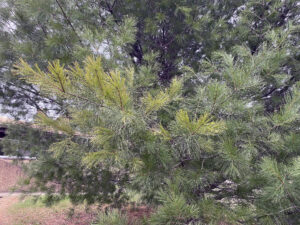By Linda Williams, DNR Forest Health Specialist, Woodruff
Linda.Williams@wisconsin.gov or 920-360-0665
Eastern white pines (Pinus strobus) can be beautiful trees in urban and forested areas (they can tower above the rest of the forest’s trees), but they can also attract a deadly disease.
White pine blister rust (Cronartium ribicola), also known as WPBR, is a fungus that can attack branches and the main stem of white pine, causing cankers that continue to grow each year and creating dead spots that can girdle branches or the main stem. Damage from a girdling canker may take years to become severe enough to cause tree decline and mortality. That means you may be able to help your trees and prevent mortality.

A branch canker on a white pine tree that could be pruned out to prevent white pine blister rust disease from reaching the main stem of the tree. / Photo Credit: Linda Williams, Wisconsin DNR
This fungal disease has been present in Wisconsin for many decades and has become common in many areas. In some cases, WPBR can cause significant losses in white pine, but it doesn’t infect all white pines in an area, so successful regeneration is still practical. The presence of this disease should not dissuade you from planting white pine or encouraging the natural regeneration of white pine.
Most rust fungi require two hosts to complete their life cycle. WPBR requires both white pine and gooseberry (Ribes sp.) to complete its life cycle. Because of this complex life cycle, the fungus cannot be transmitted directly from one tree to another. Instead, the spores produced by the fungus are blown by the wind, so the gooseberry plants may be a quarter mile away from your trees, but the spores can still be blown around and reach the trees.
Each year, the fungus fruits on white pine in the spring and fruits on Ribes sp. later in the summer. Orange pustules erupt around the edges of the canker on white pines that are infected.
Wet or damp needles are required for the initial infection to begin. The fungi must grow into a needle first, and then it can move into the branch. From the branch, the infection can eventually reach the main stem of the tree and form a girdling canker that kills the tree. When white pine are young, they often have needles connected directly to the main stem, allowing the fungus to quickly move from the needle into the main stem. Because of this, it can be more common to find cankers near the base of young trees.

White pine tree branches with white pine blister rust cankers will be off-color and eventually will die from the girdling canker. / Photo Credit: Linda Williams, Wisconsin DNR
There are some things that you can do to minimize problems with WPBR or to address it once you see it in your trees.
- Maintain dense stocking in young plantations and expect some mortality
- Prune lower branches of saplings to facilitate better airflow around the trees
- Prune out infected branches
Maintaining a dense stocking in young plantings will help increase natural pruning of the lower branches, which are most susceptible to infection. Manually pruning off lower branches on young trees can also be helpful in removing infections occurring on those lower branches before they reach the main stem. Removing the lower branches can also allow better airflow throughout the stand and under the trees, which is beneficial in keeping those lower branches drier.
Monitoring your plantings for basal cankers, or cankers on the main stem, will allow you to remove those trees promptly, giving healthy trees more room to grow.

A white pine blister rust canker at the base of a young white pine. Note the copious amount of pitch (tree resin), which is common around blister rust cankers. / Photo Credit: Linda Williams, Wisconsin DNR
Pruning infected branches can prevent the disease from growing down the branch and into the main stem, where it could eventually girdle the tree. Branches with cankers can be easy to spot; just look for a branch that is pale green compared to the rest of the tree, or, if the branch has just died, it will be a rusty red color that stands out from the rest of the tree.
Young trees that are infected near the ground may not be killed until they’re 6-8 years old. Watch for whole trees that are turning off-color and check the base for sunken areas or areas with lots of pitch flow. Those conditions could indicate a canker at the base of the tree.
